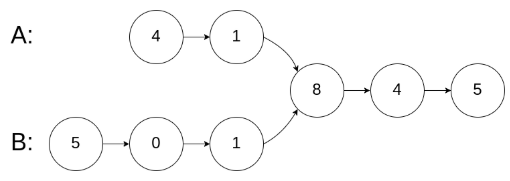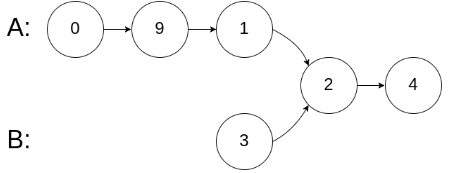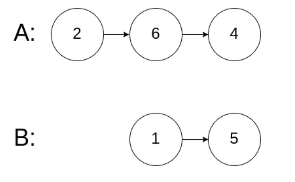
编写一个程序,找到两个单链表相交的起始节点。
如下面的两个链表:

在节点 c1 开始相交。
示例 1:

输入:intersectVal = 8, listA = [4,1,8,4,5], listB = [5,0,1,8,4,5], skipA = 2, skipB = 3
输出:Reference of the node with value = 8
输入解释:相交节点的值为 8 (注意,如果两个列表相交则不能为 0)。从各自的表头开始算起,链表 A 为 [4,1,8,4,5],链表 B 为 [5,0,1,8,4,5]。在 A 中,相交节点前有 2 个节点;在 B 中,相交节点前有 3 个节点。
示例 2:

输入:intersectVal = 2, listA = [0,9,1,2,4], listB = [3,2,4], skipA = 3, skipB = 1
输出:Reference of the node with value = 2
输入解释:相交节点的值为 2 (注意,如果两个列表相交则不能为 0)。从各自的表头开始算起,链表 A 为 [0,9,1,2,4],链表 B 为 [3,2,4]。在 A 中,相交节点前有 3 个节点;在 B 中,相交节点前有 1 个节点。
示例 3:

输入:intersectVal = 0, listA = [2,6,4], listB = [1,5], skipA = 3, skipB = 2
输出:null
输入解释:从各自的表头开始算起,链表 A 为 [2,6,4],链表 B 为 [1,5]。由于这两个链表不相交,所以 intersectVal 必须为 0,而 skipA 和 skipB 可以是任意值。
解释:这两个链表不相交,因此返回 null。
注意:
如果两个链表没有交点,返回 null.
在返回结果后,两个链表仍须保持原有的结构。
可假定整个链表结构中没有循环。
程序尽量满足 O(n) 时间复杂度,且仅用 O(1) 内存。
思路:相交的链表,一定是同一个尾,所以先遍历两个链表,顺便统计长度。
判断是否相交。
让长的那个先走长出的那部分,然后两边一起往后走,一定会相交。
/*** Definition for singly-linked list.* public class ListNode {* int val;* ListNode next;* ListNode(int x) {* val = x;* next = null;* }* }*/
public class Solution {public ListNode getIntersectionNode(ListNode headA, ListNode headB) {if(headB==null || headA==null){return null;}ListNode tempA=headA;ListNode tempB=headB;int a=0;int b=0;while(tempA.next!=null){tempA=tempA.next;a++;}while(tempB.next!=null){tempB=tempB.next;b++;}if(tempB!=tempA){return null;}tempA=headA;tempB=headB;if(a>b){for(int i=0;i<a-b;i++){tempA=tempA.next;}}else{for(int i=0;i<b-a;i++){tempB=tempB.next;}}while(tempB!=tempA){tempA=tempA.next;tempB=tempB.next;}return tempA;}
}


-leetcode-剑指offer1)



-leetcode-剑指offer2)
)

)
-leetcode-剑指offer3)


-leetcode-剑指offer4)

-leetcode-剑指offer5)



-leetcode-剑指offer7)